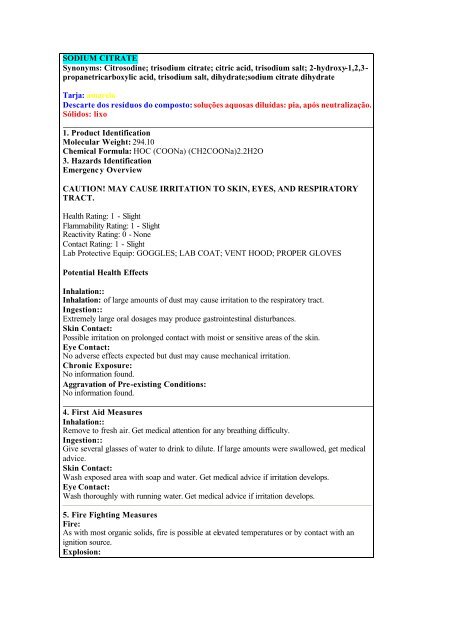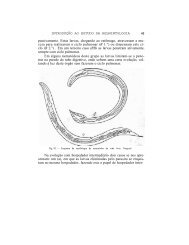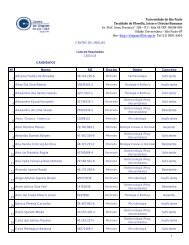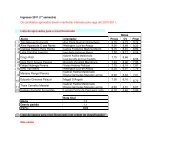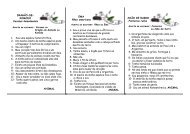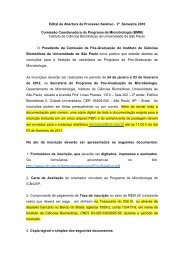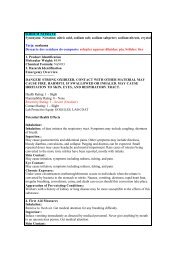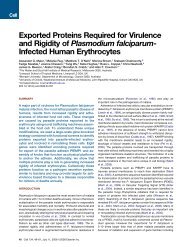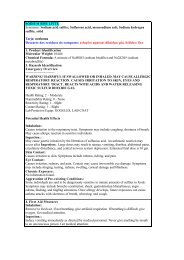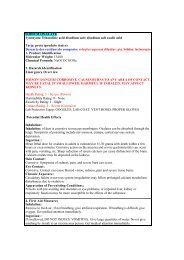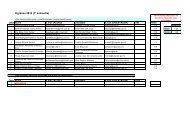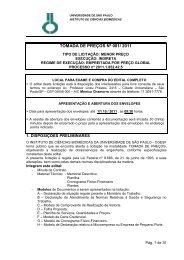SODIUM CITRATE Synonyms: Citrosodine; trisodium citrate ... - USP
SODIUM CITRATE Synonyms: Citrosodine; trisodium citrate ... - USP
SODIUM CITRATE Synonyms: Citrosodine; trisodium citrate ... - USP
Create successful ePaper yourself
Turn your PDF publications into a flip-book with our unique Google optimized e-Paper software.
<strong>SODIUM</strong> <strong>CITRATE</strong><br />
<strong>Synonyms</strong>: <strong>Citrosodine</strong>; <strong>trisodium</strong> <strong>citrate</strong>; citric acid, <strong>trisodium</strong> salt; 2-hydroxy-1,2,3-<br />
propanetricarboxylic acid, <strong>trisodium</strong> salt, dihydrate;sodium <strong>citrate</strong> dihydrate<br />
Tarja: amarela<br />
Descarte dos resíduos do composto: soluções aquosas diluídas: pia, após neutralização.<br />
Sólidos: lixo<br />
1. Product Identification<br />
Molecular Weight: 294.10<br />
Chemical Formula: HOC (COONa) (CH2COONa)2.2H2O<br />
3. Hazards Identification<br />
Emergenc y Overview<br />
CAUTION! MAY CAUSE IRRITATION TO SKIN, EYES, AND RESPIRATORY<br />
TRACT.<br />
Health Rating: 1 - Slight<br />
Flammability Rating: 1 - Slight<br />
Reactivity Rating: 0 - None<br />
Contact Rating: 1 - Slight<br />
Lab Protective Equip: GOGGLES; LAB COAT; VENT HOOD; PROPER GLOVES<br />
Potential Health Effects<br />
Inhalation::<br />
Inhalation: of large amounts of dust may cause irritation to the respiratory tract.<br />
Ingestion::<br />
Extremely large oral dosages may produce gastrointestinal disturbances.<br />
Skin Contact:<br />
Possible irritation on prolonged contact with moist or sensitive areas of the skin.<br />
Eye Contact:<br />
No adverse effects expected but dust may cause mechanical irritation.<br />
Chronic Exposure:<br />
No information found.<br />
Aggravation of Pre-existing Conditions:<br />
No information found.<br />
4. First Aid Measures<br />
Inhalation::<br />
Remove to fresh air. Get medical attention for any breathing difficulty.<br />
Ingestion::<br />
Give several glasses of water to drink to dilute. If large amounts were swallowed, get medical<br />
advice.<br />
Skin Contact:<br />
Wash exposed area with soap and water. Get medical advice if irritation develops.<br />
Eye Contact:<br />
Wash thoroughly with running water. Get medical advice if irritation develops.<br />
5. Fire Fighting Measures<br />
Fire:<br />
As with most organic solids, fire is possible at elevated temperatures or by contact with an<br />
ignition source.<br />
Explosion:<br />
Fine dust dispersed in air in sufficient concentrations, and in the presence of an ignition source
Fine dust dispersed in air in sufficient concentrations, and in the presence of an ignition source<br />
is a potential dust explosion hazard.<br />
Fire Extinguishing Media:<br />
Water spray, dry chemical, alcohol foam, or carbon dioxide.<br />
Special Information:<br />
In the event of a fire, wear full protective Clothing and NIOSH-approved self-contained<br />
breathing apparatus with full facepiece operated in the pressure demand or other positive<br />
pressure mode.<br />
6. Accidental Release Measures<br />
Remove all sources of ignition. Ventilate area of leak or spill. Wear appropriate personal<br />
protective equipment as specified in Section 8. Spills: Clean up spills in a manner that does not<br />
disperse dust into the air. Use non-sparking tools and equipment. Reduce airborne dust and<br />
prevent scattering by moistening with water. Pick up spill for recovery or disposal and place in<br />
a closed container.<br />
7. Handling: and Storage<br />
Keep in a tightly closed container, stored in a cool, dry, ventilated area. Protect against<br />
physical damage. Isolate from incompatible substances. Containers of this material may be<br />
hazardous when empty since they retain product residues (dust, solids); observe all warnings<br />
and precautions listed for the product.<br />
8. Exposure Controls/Personal Protection<br />
Airborne Exposure Limits:<br />
- OSHA Permissible Exposure Limit (PEL):<br />
15 mg/m3 total dust, 5 mg/m3 respirable fraction for nuisance dusts.<br />
- ACGIH Threshold Limit Value (TLV):<br />
10 mg/m3 total dust containing no asbestos and < 1% crystalline silica for Particulates Not<br />
Otherwise Classified (PNOC).<br />
Ventilation System:<br />
In general, dilution ventilation is a satisfactory health hazard control for this substance.<br />
However, if conditions of use create discomfort to the worker, a local exhaust system should<br />
be considered.<br />
Personal Respirators (NIOSH Approved):<br />
If the exposure limit is exceeded and engineering controls are not feasible, a half facepiece<br />
particulate respirator (NIOSH type N95 or better filters) may be worn for up to ten times the<br />
exposure limit or the maximum use concentration specified by the appropriate regulatory<br />
agency or respirator supplier, whichever is lowest.. A full-face piece particulate respirator<br />
(NIOSH type N100 filters) may be worn up to 50 times the exposure limit, or the maximum<br />
use concentration specified by the appropriate regulatory agency, or respirator supplier,<br />
whichever is lowest. If oil particles (e.g. lubricants, cutting fluids, glycerine, etc.) are present,<br />
use a NIOSH type R or P filter. For emergencies or instances where the exposure levels are<br />
not known, use a full-facepiece positive -pressure, air-supplied respirator. WARNING: Airpurifying<br />
Respirators do not protect workers in oxygen-deficient atmospheres.<br />
Skin Protection:<br />
Wear protective gloves and clean body-covering Clothing.<br />
Eye Protection:<br />
Use chemical safety goggles. Maintain eye wash fountain and quick-drench facilities in work<br />
area.<br />
9. Physical and Chemical Properties<br />
Appearance: White crystals.<br />
Odor: Odorless.<br />
Solubility: 72 g/100 g of water.<br />
Density: ca. 1.7
Density: ca. 1.7<br />
pH: ca. 8.0<br />
% Volatiles by volume @ 21C (70F): 0<br />
Boiling Point: Decomposes at red heat.<br />
Melting Point: 150C (302F)<br />
10. Stability and Reactivity<br />
Stability:<br />
Stable under ordinary conditions of use and Storage.<br />
Hazardous Decomposition Products:<br />
Carbon dioxide and carbon monoxide may form when heated to decomposition.<br />
Hazardous Polymerization:<br />
Will not occur.<br />
Incompatibilities:<br />
Strong oxidizers.<br />
Conditions to Avoid:<br />
Heat, flame, ignition sources, dusting and incompatibles.<br />
11. Toxicological Information<br />
No LD50/LC50 information found relating to normal routes of occupational exposure.<br />
<strong>SODIUM</strong> HEXAMETAPHOSPHATE<br />
<strong>Synonyms</strong>: Hexametaphosphate, sodium salt; SHMP; Metaphosphoric acid, hexadosium<br />
salt; Sodium polyphosphates, glassy<br />
Tarja: nenhuma<br />
Descarte dos resíduos do composto: soluções aquosas diluídas: pia. Sólidos: lixo<br />
1. Product Identification<br />
Molecular Weight: Not applicable to mixtures.<br />
Chemical Formula: Na(x+2) Px O(3x+1) x = 6 to 21<br />
3. Hazards Identification<br />
Emergency Overview<br />
CAUTION! MAY CAUSE IRRITATION TO SKIN, EYES, AND RESPIRATORY<br />
TRACT. MAY BE HARMFUL IF SWALLOWED OR INHALED.<br />
Health Rating: 1 - Slight<br />
Flammability Rating: 0 - None<br />
Reactivity Rating: 0 - None<br />
Contact Rating: 1 - Slight<br />
Lab Protective Equip: GOGGLES; LAB COAT<br />
Potential Health Effects<br />
Many of the systemic effects given below were taken from toxicity information for other<br />
phosphates.<br />
Inhalation::<br />
May cause irritation to the respiratory tract. Symptoms may include coughing and shortness of<br />
breath.<br />
Ingestion::<br />
Phosphates are slowly and incompletely absorbed when ingested, and seldom result in<br />
systemic effects. Such effects, however, have occurred. Symptoms may include vomiting,<br />
lethargy, diarrhea, blood chemistry effects, heart disturbances and central nervous system
lethargy, diarrhea, blood chemistry effects, heart disturbances and central nervous system<br />
effects. The toxicity of phosphates is because of their ability to sequester calcium. Systemic<br />
acidosis may result as this material is believed to hydrolyze into phosphoric acid when<br />
ingested.<br />
Skin Contact:<br />
May cause irritation with redness and pain.<br />
Eye Contact:<br />
May cause irritation, redness and pain.<br />
Chronic Exposure:<br />
May sequester calcium and cause calcium phosphate deposits in the kidneys. Chronic<br />
Ingestion: or Inhalation: may induce systemic phosphorous poisoning. Liver damage, kidney<br />
damage, jaw/tooth abnormalities, blood disorders and cardiovascular effects can result.<br />
Aggravation of Pre-existing Conditions:<br />
Persons with pre-existing skin disorders or eye problems, jaw/tooth abnormalities, or impaired<br />
liver, kidney or respiratory function may be more susceptible to the effects of the substance.<br />
4. First Aid Measures<br />
Inhalation::<br />
Remove to fresh air. Get medical attention for any breathing difficulty.<br />
Ingestion::<br />
Give large amounts of water to drink. Never give anything by mouth to an unconscious<br />
person. Get medical attention.<br />
Skin Contact:<br />
Immediately flush skin with plenty of water for at least 15 minutes. Remove contaminated<br />
Clothing and shoes. Wash Clothing before reuse. Thoroughly clean shoes before reuse. Get<br />
medical attention if irritation develops.<br />
Eye Contact:<br />
Immediately flush eyes with plenty of water for at least 15 minutes, lifting upper and lower<br />
eyelids occasionally. Get medical attention if irritation persists.<br />
5. Fire Fighting Measures<br />
Fire:<br />
Not considered to be a fire hazard.<br />
Explosion:<br />
Not considered to be an explosion hazard.<br />
Fire Extinguishing Media:<br />
Use any means suitable for extinguishing surrounding fire.<br />
Special Information:<br />
In the event of a fire, wear full protective Clothing and NIOSH-approved self-contained<br />
breathing apparatus with full facepiece operated in the pressure demand or other positive<br />
pressure mode.<br />
6. Accidental Release Measures<br />
Ventilate area of leak or spill. Wear appropriate personal protective equipment as specified in<br />
Section 8. Spills: Sweep up and containerize for reclamation or disposal. Vacuuming or wet<br />
sweeping may be used to avoid dust dispersal. Small amounts of residue may be flushed to<br />
sewer with plenty of water.<br />
7. Handling: and Storage<br />
Keep in a tightly closed container, stored in a cool, dry, ventilated area. Protect against<br />
physical damage. Isolate from incompatible substances. Containers of this material may be<br />
hazardous when empty since they retain product residues (dust, solids); observe all warnings<br />
and precautions listed for the product.
8. Exposure Controls/Personal Protection<br />
Airborne Exposure Limits:<br />
None established.<br />
Ventilation System:<br />
In general, dilution ventilation is a satisfactory health hazard control for this substance.<br />
However, if conditions of use create discomfort to the worker, a local exhaust system should<br />
be considered.<br />
Personal Respirators (NIOSH Approved):<br />
For conditions of use where exposure to dust or mist is apparent and engineering controls are<br />
not feasible, a particulate respirator (NIOSH type N95 or better filters) may be worn. If oil<br />
particles (e.g. lubricants, cutting fluids, glycerine, etc.) are present, use a NIOSH type R or P<br />
filter. For emergencies or instances where the exposure levels are not known, use a full-face<br />
positive-pressure, air-supplied respirator. WARNING: Air-purifying Respirators do not<br />
protect workers in oxygen-deficient atmospheres.<br />
Skin Protection:<br />
Wear protective gloves and clean body-covering Clothing.<br />
Eye Protection:<br />
Use chemical safety goggles. Maintain eye wash fountain and quick-drench facilities in work<br />
area.<br />
9. Physical and Chemical Properties<br />
Appearance: White powder or plates.<br />
Solubility: Soluble in water.<br />
Density: 1.25<br />
% Volatiles by volume @ 21C (70F): 0<br />
Boiling Point: 1500C (2732F)<br />
Melting Point: 550C (1022F)<br />
10. Stability and Reactivity<br />
Stability:<br />
Stable under ordinary conditions of use and Storage.<br />
Hazardous Decomposition Products:<br />
Sodium and phosphorus oxides may form when heated to decomposition.<br />
Hazardous Polymerization:<br />
Will not occur.<br />
Incompatibilities:<br />
No information found.<br />
Conditions to Avoid:<br />
No information found.<br />
11. Toxicological Information<br />
Oral rat LD50: 3053 mg/kg


